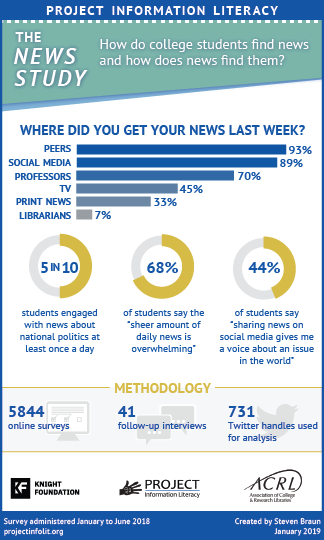The Lede: How Do Students Engage With News?
 The news can be an overwhelming hodge-podge of headlines, posts, alerts, tweets, memes, visuals, and casual conversation –for students as well as faculty. Making sense of it is a tall order, especially when real and accurate content sometimes seems beyond description. How do students do it? Insights can be gained from a new report How Students Engage With News from Project Information Literacy (PIL), with five key research takeaways.
The news can be an overwhelming hodge-podge of headlines, posts, alerts, tweets, memes, visuals, and casual conversation –for students as well as faculty. Making sense of it is a tall order, especially when real and accurate content sometimes seems beyond description. How do students do it? Insights can be gained from a new report How Students Engage With News from Project Information Literacy (PIL), with five key research takeaways.
PIL is a nonprofit research institute that studies what students think and do in their digital lives. Based in the San Francisco Bay area, it pursues questions through and beyond higher education, when “information literacy” can become a life skill (such as: reading a lease). PIL has worked with 260 institutions: community colleges, land-grant universities, private colleges and universities, using mixed methods and analysis with full ethical review. It produces summaries of key findings, in-depth data, and makes recommendations.
Students do not approach news merely passively or at random. Some take deep dives; most recognize that engaging news requires effort to assemble and evaluate information. A 2016 study from Stanford showed students’ inability to differentiate “fake news” from “real news,” even at Stanford. Many other questions remain, and in two years many students have become far more savvy. PIL has discovered five takeaways:
How does this matter for teaching? Many of the skills that students develop (or attempt) involve evaluation of content, determining authority, and understanding context and nuance. These are all directly parallel to skills students need to learn in class. Professors can help teach “knowledge in action” by building such skills that extend from academic content to news media. Faculty should reconsider how we teach evaluation of sources, and bring discussion of the context of information –curricular, media—to the foreground. Faculty can also critique social media companies and the way they handle—or refuse to handle—news and the consequences of their platforms.
The News Study Report is timely, helpful, and a real contribution to these skills, habits, and dispositions that are so vital to our students’ success in university and beyond. Tolle, lege: Take and read!
A Resource You Should Know About: Zoterobib
 Zotero is citation management software, a tool to help keep track of citations, format them correctly, and build bibliographies and lists for many, different purposes. Like every tool, it has a learning curve, and requires an easy installation, and a plug-in for Microsoft Word. Even though it’s easy, that’s too much for many people. The solution? Zoterobib: a free web service that builds a bibliography from any device without installation. You can use it in Chrome, Firefox, and Safari. You can store your bibliography on your local workstation or upload it to zbib.org, where it will be private, stored for at least six months from the date of last use. As with all software, you should proof-read Zoterobib citations, especially where APA requires titles to be in “Sentence case” rather than in “Title case” (Circadian Mood Variations in Twitter Content vs. Circadian mood variations in Twitter content—you have to capitalize the T manually). Zoterobib is free, easy, and is free of all advertising.
Zotero is citation management software, a tool to help keep track of citations, format them correctly, and build bibliographies and lists for many, different purposes. Like every tool, it has a learning curve, and requires an easy installation, and a plug-in for Microsoft Word. Even though it’s easy, that’s too much for many people. The solution? Zoterobib: a free web service that builds a bibliography from any device without installation. You can use it in Chrome, Firefox, and Safari. You can store your bibliography on your local workstation or upload it to zbib.org, where it will be private, stored for at least six months from the date of last use. As with all software, you should proof-read Zoterobib citations, especially where APA requires titles to be in “Sentence case” rather than in “Title case” (Circadian Mood Variations in Twitter Content vs. Circadian mood variations in Twitter content—you have to capitalize the T manually). Zoterobib is free, easy, and is free of all advertising.
 Librarians have gained expertise with instructional sessions via WebEx with a graduate Nursing research course, NU601. This experience has shown that WebEx is a viable and scalable alternative to direct individual consultations or multiple classroom visits. Originally most useful with distance online students, WebEx in fact works equally well across campus, and also allows multiple, shorter sessions from which content and skills can be more readily absorbed. Librarians are ready to provides services via WebEx –please contact the library Reference service (reference@sacredheart.edu or 203-371-7726, or via chat) for more information.
Librarians have gained expertise with instructional sessions via WebEx with a graduate Nursing research course, NU601. This experience has shown that WebEx is a viable and scalable alternative to direct individual consultations or multiple classroom visits. Originally most useful with distance online students, WebEx in fact works equally well across campus, and also allows multiple, shorter sessions from which content and skills can be more readily absorbed. Librarians are ready to provides services via WebEx –please contact the library Reference service (reference@sacredheart.edu or 203-371-7726, or via chat) for more information.
Service Notes
The Library welcomes Sharaya Smith as User Services Assistant. You can meet Sharaya, usually at the main library service desk in Ryan Matura Library. Sharaya has deep experience at Bridgeport Public Library and the U.S. Air Force. Welcome, Sharaya!
The Library will also welcome Susan Luchars as Resource Development and Assessment Librarian, beginning Monday, November 26. Susan is already well-known to the community in her role as part-time evening and weekend reference librarian, on Sunday afternoons and Monday evenings. All her colleagues look forward to working with her regularly as a full-time member of the team.
Budget constraints have required the Library temporarily to suspend further access to new videos through the demand-driven acquisition (leasing) program with Kanopy Streaming Video. Faculty members who need a new video for scheduled instruction should consult a librarian; a video already in the 365-day lease period may be an adequate substitute. New videos can also be leased on a case-by-case basis. Please speak with a librarian if you have questions.

FIND US ON